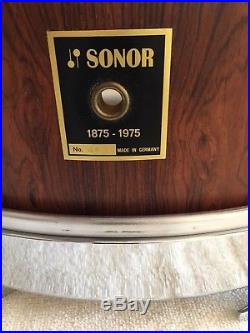
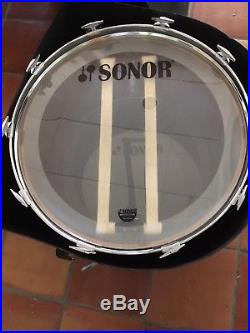
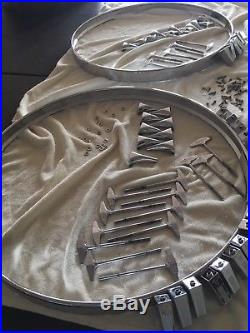
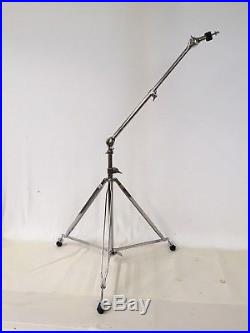
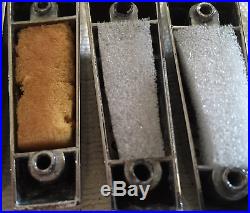
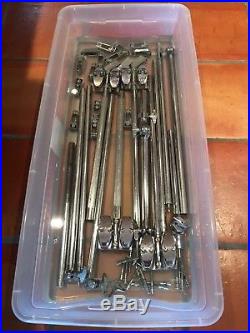
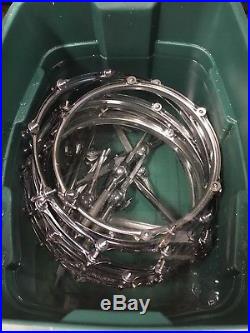
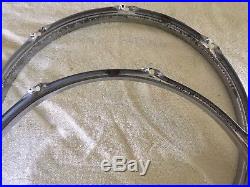
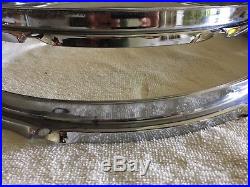
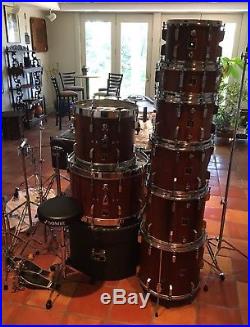
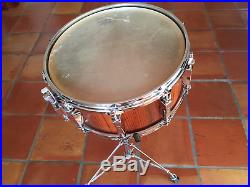


10 December update: Descriptive information expanded. Photo gallery with close-ups and more info are on my Photobucket page. To access these photos. For informational updates (ongoing) please r ead progress reports further down for specifics. This listing is “in progress” with pics and descriptive information being added or updated on an ongoing basis. I’ll happily respond to all questions comments, observations. And suggestions to this listing and they will be posted and shared for your consideration (see Viewer Q&A below). Overview: This offer is for a 1975 SONOR Phonic 8 piece drum set, stands, cases, cymbals and more. In the’70s the set was top-of-the-line and still holds its own (and then some) when compared to the best products available today. I encourage interested buyers that may understandably be focused on the drums and stands only i. Omitting accessories, cases, cymbals, etc. That is, drum by drum or certain stands and not others. I never could have afforded them otherwise and really, at the time, couldn’t then either. While it was well-used, it was also very well cared for, hence you may notice in the pics the beautiful rosewood shells are devoid of gashes and scratches that are almost always found in used wooden drums, especially of this age. Thus, there is no question as to the legitimacy of date of manufacture. Too, in 1975, the Cold War was still well underway with Germany a. Divided country, separated post World War II into. Therefore you will see “Made in Western Germany” stamped onto certain of the chrome hardware (see pic examples). Rosewood: For generations now Rosewood has been listed in the most restrictive category of endangered wood species please search reference: CITIES Appendix I. For protected wood species information. I believe this rosewood is of Brazilian origin. Indeed I was asked to change my order to a different finish, which I declined. However they raised the price not once but twice before finally agreeing to the build! A kind of “composite” rosewood veneer is still available from SONOR today IF. You can afford it. Is certainly not the Brazilian species or for that matter any of the quality veneers that were available many decades ago. For more on this, read the message (Viewer Q&A below) from Jackk7225 who has provided further insight on the subject. Danh6036 who has provided me valuable information on proper cleaning and restoration tips that I used on the kit and hardware. Drum Configurations: The following are the types and sizes where the first number is the diameter, the second is depth… Snare 14×6; Toms 12×8, 14×10, 15×12, 16×14; Floor Tom 18×16; Bass Drum 24×14; Bass Drum 18×14. I have given each drum and all the components a thorough inspection for flaws or issues. These have been detailed in the Progress Reports below and further expanded upon in the Photobucket link. Cleaning included complete disassembly of the lugs, rims and tension rod hardware from the wooden shells, needed so I could best apply. Lemon oil to the wood. Each drum received a hand-applied carnauba waxing and polishing. Every lug, hoop and stand received a citric acid soak in order to remove oxidation patina and light rust from some of the chrome that had accumulated over the decades. A metal polish was then applied and hand-polished for reassembly as the final touch. Why did I do this? Because the set deserves to be presented in its best light and because the proud new owner will not have to perform this very tedious, time-consuming task and will take joy in immediate use of the kit. Territories and International buyers! Progress Reports yes, restoration has taken a long time! When fully extended the stand is a useable height of 50. Almost all date from the 70s. Among them: Paiste 22 dark ride – my favorite! , 14 hi-hats dark sound edge, ex. Zildjian: 22″ (pang aka china type), 18″ (crash ride), 16″ (crash), 15″ hi-hats, 13″ (crash), 12″ (crash). Pics for all will be added to the listing in its final version. Same with the tension rods, left is before, right after. The lug sponge-foam inserts were also removed before cleaning and reinstalled. Most are intact as you can just see in the pic and where not they will be replaced with a hand-cut sponge-foam material for a functional match. A unique SONOR feature was the locking nut mated to each tension rod. This was often confused as being needed when tuning the head really tight… However the exact opposite was the intent! When a head is very loosely tensioned for lower tuning, the associated tension rods could loosen further on their own from repeated beatings on the head resulting in rattling or buzzing noises. The locking nuts eliminate that problem. The internal lug sponge-foam inserts were used to ensure the lug springs stayed in place regardless of how loose the tension rods were. A rather clever idea! This will be followed by additional hand cleaning and polishing. This was followed by each piece getting soap washed by hand to ensure no acid residue remains. Then all were hand dried. Everything is sparkling as is but will be further enhanced with an upcoming application of White Diamond Metal Polish on all of the metal parts to ensure it stays that way. They are the ONLY hoops in the entire collection displaying this sort of issue. While the acid bath did improve the condition to these from what it was, it cannot fully correct it. The only way to deal with it is. Re-plating the metal, something the new owner can decide to do if they feel it is important enough. I have no recollection how this could have happened… Maybe some spilled liquid that I wasn’t aware of done way back when? And left uncleaned, it eventually corroded portions of the metal. The odd thing is that it is on both hoops rather than just the top one. The good news is that when the hoops are installed to the head and drum the discoloration cannot be seen because it is located inside on the lower flange. That is to say the sides and top portion of the rims are cosmetically clean for all intents and purposes. Pic 9 demonstrates this with Pic 10, the floor tom, indicative of how the drums will look after cleaning and carnauba waxing. The rubber feet for all were removed prior to and hand cleaned in simple soap and water and are now free of all cooties. What can only be described as “beefy” rubber feet are mated to the threaded spiked foot of the stand. SONOR went the extra step of using a machined brass threaded insert to ensure the long term integrity of the rubber was retained even with heavy use. Accordingly not one of the rubber feet are broken or cracked! Maybe there are other manufacturers who do this but SONOR is the only one I’m aware of that built in a machined brass insert rather than using a stamped metal washer, if they used anything at all. Everything went well but I discovered a small rust spot on one (only) of the lugs. Can’t be easily seen. I will get a close-up of it and all other items that would be deemed less than pristine. Thankfully there’s only a few and I will post additional pics on these at a later date. Back to the snare Pic 11… Yes, that is a genuine AmRawCo calf skin head, probably from the late 1950s or early 60s, mounted on the snare which is perched on its original and period correct SONOR stand. No issues apparent other than the grease used internally in the stand mech had partially solidified because of years of non-use. This should be remedied by solvent-aided removal, then an application of fresh grease. Sponge-foam inserts, present in each lug, have become dry, brittle and sometimes literally disintegrate when I remove them which is needed to properly clean the lug. Pic 5 typifies this process with the leftmost lug. And the middle and rightmost with replacement sponge foam installed. This is easily corrected simply by replacing the existing screws with the same kind, but slightly longer so as to allow. Threading and to have it hold for the long term. A close look at Pic 5 replaced reveals the issue with the left lug having normal condition flange nuts, the middle lug displaying the problem to both the top and bottom nut flange, and the right lug with normal top nut and worn bottom nut. While the condition is specific to the floor tom (and not the others I have completed). It is possible I will encounter more of the same. They will be dealt with in similar fashion. I have come to the conclusion that there was nothing at all age-related to lug nut condition. Rather, I evidently let these particular lugs soak for too long in the citric acid bath and this resulted in several of the lug nut threads softening. As I reapplied the screws to them, and although I’m tightening with a hand tool, the softened threads simply dissolved into a kind of particulate grease-mush. Shows why it is necessary to replace the lug sponge foam inserts. When the lugs are removed from the drum most of the time the remains of the sponge clings to the shell. This is easily removed and doesn’t leave a trace, but what is left of the sponge crumbles and is rendered unusable, hence replacements are fitted (as you can see in Pic 5). The rim lugs damaged in the. Citric acid soak have been replaced with period correct lugs. I remember long ago I found I had over tightened one of the support leg t-bolts and it separated with about a third of it stuck within the lug. By that time I was full time in studio doing sessions and never got around to fixing it. Instead I used a Rogers memory lock adaptor to keep it in place. Another of the three leg lugs threading became stripped. Both of these issues will be properly corrected by a visit to a machine shop. Will post an update on this as I get to it. (from top down) 14×6 snare, 14×10 tom, 15×12 tom and 18×16 floor tom. Just behind on the pool table (temporarily converted into my workbench) is the 12×8 tom undergoing disassembly for cleaning. Out of sight are the 16×14 tom, the 18×14 bass drum and the 24×14 bass drum, both of which are cleaned and reassembled except the 18 that is waiting to receive replacement felt muffles. Perhaps vibration movements caused this. It is the only one of the drums exhibiting this and it’s actually a small area, a few inches, and not so easy to see. The rosewood veneer was not penetrated enough to expose the beech ply underneath. Shown here actually attached to one of the wide base stands typically used for toms mounting but it will support the 18. As part of the set I ordered two bass drum, the 18″ and a 24″ for use in different music applications. The 18 being preferred where the setting was in tight spaces and/or. I also used it uncommonly but as shown, with mallets, in an art rock context. I’ll soon get my pool table back! Have finished the 16×14 tom and all drums are shown in Pic 10 along with a smattering of stands, some in the background and/or out of sight all together. Next I will start preparing for hi-res photos and will upload as soon as possible. One floor tom leg lug has a broken thread screw which will be removed to allow proper tightening screw insertion. Will have updated photos as soon as I can reinstalled the related hardware to the snare and floor tom. Hello, You have a truly beautiful and rare drum set here! I just wanted to pass on some information about what Sonor is calling their present day Rosewood; eg: in the SQ2 custom line and the recently discontinued S-Classix. You are correct in saying that the Rosewood veneer of today is not the same as your genuine Rosewood Centennial kit. What they are using now is called, in the wood working industry, a composite veneer. The Italian company Alpi manufactures these veneers from real wood in a way that mimics the appearance of exotic and endangered species of woods. I don’t mean to offend you by this note I just thought you might be interested to know this information. I bought a 10 piece set of phonics with concert toms back in 1978, plus a whole bunch of hardware to go with them. You didn’t even say what sizes are in the set or what hardware comes with it. I can see from the very few pictures you posted that the chrome on the hardware is bad. The chrome on phonic sets from that time period is not good. Sonor’s chrome plating in general was bad, considering how high priced there were. As far as the price goes, your delusional! Few, if any, people care about rosewood anymore. It was hard to work with then and difficult to finish. This set is only special to you. Even though I took care of them, the hardware was getting rushed. I believe what you think is rust shown in Pic 1 on the edge of the rim is actually a reflection of the bottom of the metal surround of the. In Pic 3 the rim hoops, claws and T-rods shown are all prior to cleaning and shown for purposes of supporting my claim that all hardware is being individually and thoroughly cleaned. SONOR has always had and maintains a solid reputation for top quality manufacturing, chrome plating included, although over time any metal and plating is subject to some degree of tarnishing patina or spotting. My shown price is fiction at this point which is exactly what I intend for now. The listing exists so interested persons can follow along as I work to restore the kit, in progress. Yet they sell for a premium regardless. New message from: jackk7275. Sonormuseum (slash) germany (slash) germany6 (dot html) Hi, the above address should be a link to a page from the Sonor Museum. On this page they state that some veneers used are from Alpi. Alpi manufactures the composite veneers from real wood that are intended to mimic, if you will, the exotic and endangered tree species. I hope this helps. Jack Sent from my iPhone. New message to: jackk7275. From: danh6036 To: atgiws Subject: Other: danh6036 sent a message about SONOR Phonic Series Rosewood in/out 1975 Centennial Edition RARE and EXCELLENT! Sent Date: Jun-15-18 12:50:49 PDT. Dear atgiws, Hello My Friend, I have been doing Restorations & Repairs, for most of my Life (now 61) and wanted to pass along a couple Restoration Tips, from an Old Fart who’s tried them all. The reason People use Coke/Soft Drinks to Clean/Dissolve Rust and/or Tarnish on Metal, is because it contains Citric Acid. Unfortunately, it also contains Sugars, which can have the opposite effect and it’s Expensive! So get the real thing… Now, about the Foil… Throw it away LOL! ScotchBrite is actually a Teflon Version of Steel Wool & much easier to use then Foil. I made a set of 90 year old COB Hoops look new in 5 minutes! I really appreciate the advice and I will try those suggestions. I quickly gave up on coke & foil. Agreed, a bit messy as well exhibiting somewhat marginal results. So far I’ve found that paper towels well-wetted with distilled vinegar to be the better treatment. I wrap the metal piece into the towel(s) then place it in a plastic bag for 24 hours, remove and give it a careful scrubbing with a toothbrush caked with baking soda then rinse, dry and polish. From: smitmac_lppxxnj To: atgiws Sent Date: Jul-01-18 10:46:36 PDT. Why would you not list as many pictures of the kit as you could, considering what you are asking for it? I offered you 1K for them, but you declined. Thanks for your message! There are 12 pics by my count. Could be you may have viewed the listing at some point when I was editing it and uploading pics (in rotation and noted in the description) as I progress on the restoration tasks. No, I’m not Nigerian. Native born in Philadelphia, PA, USA. It appears to me the SONOR drums you’ve link referenced are from a much more recent build and are definitely not SONOR’s Phonic series, as the listing title incorrectly states. The first thing that struck me was the bass drum hoops are wood rather chromed steel, nor do they have T-rods connecting to the claws. Oddly, they’re shown having a slotted head tension rod, as is commonly found on toms and snare, but rarely used on a bass drum. Too, I can’t remember SONOR deploying their Phonic series with wood hoops and doubt SONOR would use slotted tension rod hardware on a Phonic bass drum (or any of their lines for that matter) so this would lead me to believe the listing was not a genuine Phonic series, but probably Force or one of the less costly series SONOR offers from time to time. Years soon thereafter when they changed to a composite product. Kinda looks like rosewood, but it’s not. I’m not trying to denigrate the appearance of your drums nor the quality. But it’s certainly not comparable to this listing. Hi, I love this period as well. I have a phonic kit from the early 80’s and I bought mine when I was working in a music store. Otherwise I could never have afforded them. They also made a lambs wool variation on your internal dampening system. Just wondering, I have a recording studio in Philadelphia called Rittenhousesoundworks. I dont have 14 for a set of drums and Im wondering if you may need anything I may have or need a project recorded? Check out our site to see what Im talking about. In the meantime, I’m really looking forward to the additional photos and thank you for all the details you’re providing. My contact info is on our site. There was a time in my distant past that I’d be willing to engage in discussion of some sort of trade, however the years are piling on so, no, this will be a straight sale to someone, somewhere, at some price. Do please stay tuned as I complete the work and assess condition details to ensure my ask price is accordingly, in line. From: OddBall, vintage drum guru (via Vintage Drum Forum). Sent: Nov-12-18 20: 53. Don`t listen to those fools telling you what you got. I gave it a quick once over. So far I see a 1975 Rosewood veneer in and out, all factory. The guy that told you about the manufactured finished veneers is correct but he got his times wrong (78+). That badge only went on a drum built in 1975. Even if the date stamp says 76 or 77, it was built in 75. The post badge in 76 read “since 1875″ and the last one (except snares) read EST. Other things include those drums were the only Phonic series not to include the snaplock lugs. They used a tuning wheel. The BD`s never got either, stayed the same since the Champion series. The rosewood got a brass colored or coated badge which yours have. The rest got silver colored. You have a D-516 Snare. It`s the first run like it should be. Indicated by the small mallet logo and cut out on the lug casings. That one`s very limited to the mid 70`s. In 79 it got the large logo cut out lugs. In the 80`s it got flat bottom lugs. Oh, 14k is way out there….. It’s not a Sig. (those were Black Maple and 22K gold electroplated trim and hardware). OddBall, vintage drum guru (via Vintage Drum Forum). Thanks for the information! Considering the vintage, uniqueness of the materials, the unusually. Condition and the amount of time and effort spent to properly restore the gear, I feel 14k is warranted. You can’t be serious about this price? I don’t understand your “persistance”, nobody will pay such that amount for a Phonic: I have a Phonic, and like everybody aware of this kind of set, we know what we can get, but not this! I renew my offer about your 18′ bass drum. Will you accept to sell it separately? Be serious please, you are making a fool of yourself. Hello lechatahcel and thanks for your message and interest in the 18 drum. I’ve been monitoring SONOR drum offers and sales literally for years. Not all of them, just ones that somewhat resemble my kit in model, vintage and finish. I have yet to see anything anywhere near it in terms of quantity of drums, stands, etc. As well as condition and integrity of the components and hardware. I’ve had excellent advice, input and perspective given to me from drum specialists and shops. And of course, as is well documented in my descriptions and photos, a considerable amount of time has been spent cleaning and restoring it all to a very high level. That is why and how I’ve determined the listing ask price. Yes, it is a leap. So far, no, and I don’t expect it either! You see, I can always lower the price. And I’m pleased that I’ve had offers, though none have come close enough to what I feel is within the “strike” range. As far as parting out the components, I currently have no desire to do so although it remains a possibility, and I may, at some point change the listing to reflect that. And Season’s Greetings to you and yours! In that perspective, it’s different, I understand. Plus the fact that yours has Rosewood in/out, they are much more valuable. My set is in black plastic covering, I want to pull off the plastic and finishing with a wood covering, probably Rosewood I’m not sure. Phonic series are so good, nothing common with all those Force Series, seem so cheap. Since Sonor became propriety of Hohnerare they again? , I found the quality decreasing, except now with SQ series. But even with that line, the hardware(tom holder, etc) are ugly, huge, like Tama, at least for me. Years ago, Sonor had that subtility in the shape of hardwares, simple, pure, clean lines, heavy without being proeminent. Anyway, I suppose they didn’t have choice, with the way the market took, and so many others deciding to make their drums in China, what a shame. Anyway, best luck with your drums, you are also right not giving them, they are so valuable. Sorry for my bad english, hoping it’s understandable! Take good care, and my best Greetings too. The item “1975 SONOR Phonic 8 piece drum set withstands, cases, cymbals & more. Don’t Miss” is in sale since Tuesday, July 31, 2018. This item is in the category “Musical Instruments & Gear\Percussion\Drums\Sets & Kits”. The seller is “atgiws” and is located in Asheville, North Carolina. This item can be shipped worldwide.
- Size: Various
- Model: Phonic Series
- Modified Item: No
- Country/Region of Manufacture: Germany
- Custom Bundle: No
- Material: Rosewood veneers over beech shell
- Drum Type: Acoustic Drum Kit
- Type: Suitable for all music genres
- Brand: SONOR
- Non-Domestic Product: No
- Skill Level: Professional
- Items Included: 8 drums, stands, hi-hat, bass drum pedal, cases

Tags: cases, cymbals, don't, drum, miss, more, phonic, piece, sonor, withstands